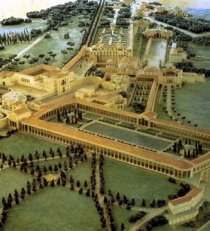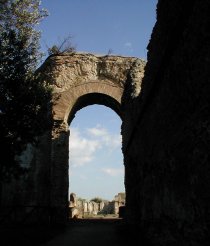From the opposite side to N.-W., beyond an empty area, a ninfeo was placed, with seven niches; of great complexity was the architecture of the first floor, much rearranged under Hadrian: we can find here Hadrian's library (a square place), a basilican hall with three naves, that remembers the basilica of the Domus Flavia on the Palatino, perhaps destined to the reunions.
The Villa extends at the slopes of the tiburtini hills, a
zone that since the republican age were considered an holiday
place, such that built their villas here, among the others,
Cesar, Catullo, Orazio and Mecenate.
Been
born from the multiform and versatile talent of Adrian
emperor, it was realized in two successive phases from
118 to 133 a.C.; not in three phases, as in accordance
with Bloch's thesis, founded on the study of the stamps
of the bricks used in the construction of the several
buildings.
The two phases of contruction and the relative
buildings can be so synthetized:
- I phase (118 -125): Libraries; northern complex of the eastern Palace (Basilica, Library); Courtyard of the Libraries; the rooms to lodge and annexed building; Garden to south-east of the Palace (pavilion to the north-east of the Public square of Gold); Terme with eliocamino; Maritime theatre; Stadium with the annexed constructions; Fire stations; Large Baths. The jobs were especially made in the period between 118 and 121.
- II phase (125 -133):the Small Terme; the central Complex of the eastern Palace; the western Palace; the Tower of Roccabruna; Golden Court; the Pretorio, the Vestibolo; the Cento Camerelle and the Pecile; Pavilion towards Tempe; Canopus; Courtyard at the east of the Stadium. Taking advantage of Hadrian's presence in Italy, the jobs briskly resumed especially between 125 and 128.






